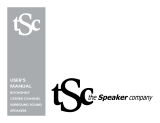
10
Caring FOr YOur sPeakers
Wipe the cabinet with a clean, dry cloth to remove dust. Damp cloths may dull the cabinet’s finish. Do not use •
volatile liquids such as benzene, paint thinner or alcohol on the cabinet.
Do not spray insecticide near the cabinet.•
To remove dust from the grille fabric, use a vacuum cleaner set to low suction. •
Do not wash the grilles in water, as it may fade the color or make it uneven.•
If the surfaces of the woofer and midrange cones become dusty, you can carefully sweep them clean with a soft, •
dry calligraphy brush or paint brush. Do not use a damp cloth.
NEVER touch anything to the tweeter dome.•
sPeCiFiCatiOns
STUDIO 190 FLOORSTANDING SPEAKER
Speaker type: Three-way dual-woofer, floorstanding
Low-frequency transducer: Two 6-1/2" (165mm) PolyPlas
™
cones, magnetically shielded
Midrange transducer: 4" (100mm) PolyPlas cone, magnetically shielded
High-frequency transducer:
1" CMMD
®
Lite dome, magnetically shielded, in a Bi-Radial
®
constant-directivity waveguide
Power handling: 100 watts (continuous); 400 watts (peak)
Frequency response: 40Hz – 22kHz
Nominal impedance: 8 ohms
Sensitivity (2.83V/1m): 90dB
Crossover frequencies: 800Hz, 3.2kHz, 6dB/octave
Enclosure type: Ported, with midrange subenclosure
Connector type: Dual gold-plated binding posts (bi-wire capable)
Dimensions (H x W x D): 44-1/8" x 7-7/8" x 14-3/4" (1121mm x 200mm x 375mm)
Weight: 48.8 lb (22.1kg)
STUDIO 180 FLOORSTANDING SPEAKER
Speaker type: Three-way floorstanding
Low-frequency transducer: 6-1/2" (165mm) PolyPlas cone, magnetically shielded
Midrange transducer: 4" (100mm) PolyPlas cone, magnetically shielded
High-frequency transducer:
1" CMMD Lite dome, magnetically shielded, in a Bi-Radial
constant-directivity waveguide
Power handling: 90 watts (continuous); 360 watts (peak)













